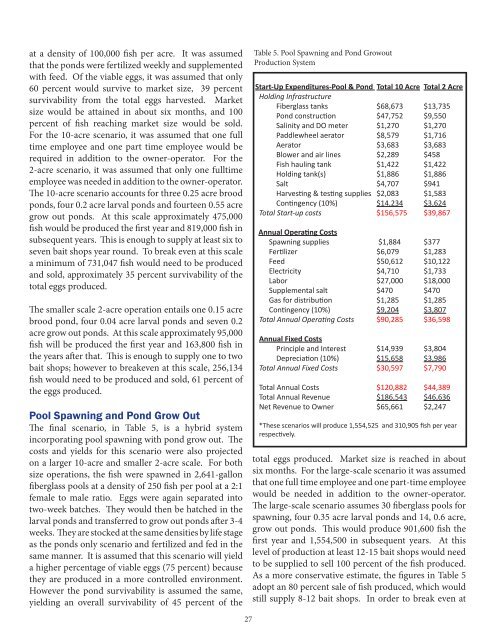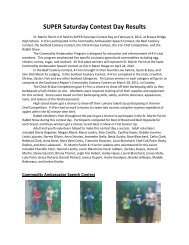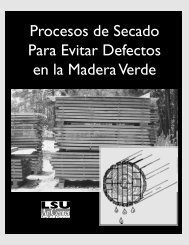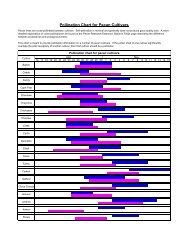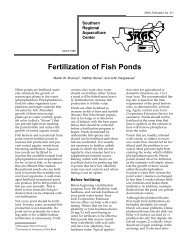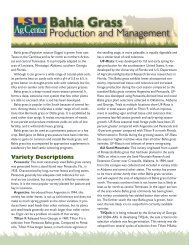Cocahoe Minnow - The LSU AgCenter
Cocahoe Minnow - The LSU AgCenter
Cocahoe Minnow - The LSU AgCenter
You also want an ePaper? Increase the reach of your titles
YUMPU automatically turns print PDFs into web optimized ePapers that Google loves.
at a density of 100,000 fish per acre. It was assumed<br />
that the ponds were fertilized weekly and supplemented<br />
with feed. Of the viable eggs, it was assumed that only<br />
60 percent would survive to market size, 39 percent<br />
survivability from the total eggs harvested. Market<br />
size would be attained in about six months, and 100<br />
percent of fish reaching market size would be sold.<br />
For the 10-acre scenario, it was assumed that one full<br />
time employee and one part time employee would be<br />
required in addition to the owner-operator. For the<br />
2-acre scenario, it was assumed that only one fulltime<br />
employee was needed in addition to the owner-operator.<br />
<strong>The</strong> 10-acre scenario accounts for three 0.25 acre brood<br />
ponds, four 0.2 acre larval ponds and fourteen 0.55 acre<br />
grow out ponds. At this scale approximately 475,000<br />
fish would be produced the first year and 819,000 fish in<br />
subsequent years. This is enough to supply at least six to<br />
seven bait shops year round. To break even at this scale<br />
a minimum of 731,047 fish would need to be produced<br />
and sold, approximately 35 percent survivability of the<br />
total eggs produced.<br />
<strong>The</strong> smaller scale 2-acre operation entails one 0.15 acre<br />
brood pond, four 0.04 acre larval ponds and seven 0.2<br />
acre grow out ponds. At this scale approximately 95,000<br />
fish will be produced the first year and 163,800 fish in<br />
the years after that. This is enough to supply one to two<br />
bait shops; however to breakeven at this scale, 256,134<br />
fish would need to be produced and sold, 61 percent of<br />
the eggs produced.<br />
Pool Spawning and Pond Grow Out<br />
<strong>The</strong> final scenario, in Table 5, is a hybrid system<br />
incorporating pool spawning with pond grow out. <strong>The</strong><br />
costs and yields for this scenario were also projected<br />
on a larger 10-acre and smaller 2-acre scale. For both<br />
size operations, the fish were spawned in 2,641-gallon<br />
fiberglass pools at a density of 250 fish per pool at a 2:1<br />
female to male ratio. Eggs were again separated into<br />
two-week batches. <strong>The</strong>y would then be hatched in the<br />
larval ponds and transferred to grow out ponds after 3-4<br />
weeks. <strong>The</strong>y are stocked at the same densities by life stage<br />
as the ponds only scenario and fertilized and fed in the<br />
same manner. It is assumed that this scenario will yield<br />
a higher percentage of viable eggs (75 percent) because<br />
they are produced in a more controlled environment.<br />
However the pond survivability is assumed the same,<br />
yielding an overall survivability of 45 percent of the<br />
27<br />
Table 5. Pool Spawning and Pond Growout<br />
Production System<br />
Start-Up Expenditures-Pool & Pond Total 10 Acre Total 2 Acre<br />
Holding Infrastructure<br />
Fiberglass tanks $68,673 $13,735<br />
Pond construction $47,752 $9,550<br />
Salinity and DO meter $1,270 $1,270<br />
Paddlewheel aerator $8,579 $1,716<br />
Aerator $3,683 $3,683<br />
Blower and air lines $2,289 $458<br />
Fish hauling tank $1,422 $1,422<br />
Holding tank(s) $1,886 $1,886<br />
Salt $4,707 $941<br />
Harvesting & testing supplies $2,083 $1,583<br />
Contingency (10%) $14,234 $3,624<br />
Total Start-up costs $156,575 $39,867<br />
Annual Operating Costs<br />
Spawning supplies $1,884 $377<br />
Fertilizer $6,079 $1,283<br />
Feed $50,612 $10,122<br />
Electricity $4,710 $1,733<br />
Labor $27,000 $18,000<br />
Supplemental salt $470 $470<br />
Gas for distribution $1,285 $1,285<br />
Contingency (10%) $9,204 $3,807<br />
Total Annual Operating Costs $90,285 $36,598<br />
Annual Fixed Costs<br />
Principle and Interest $14,939 $3,804<br />
Depreciation (10%) $15,658 $3,986<br />
Total Annual Fixed Costs $30,597 $7,790<br />
Total Annual Costs $120,882 $44,389<br />
Total Annual Revenue $186,543 $46,636<br />
Net Revenue to Owner $65,661 $2,247<br />
*<strong>The</strong>se scenarios will produce 1,554,525 and 310,905 fish per year<br />
respectively.<br />
total eggs produced. Market size is reached in about<br />
six months. For the large-scale scenario it was assumed<br />
that one full time employee and one part-time employee<br />
would be needed in addition to the owner-operator.<br />
<strong>The</strong> large-scale scenario assumes 30 fiberglass pools for<br />
spawning, four 0.35 acre larval ponds and 14, 0.6 acre,<br />
grow out ponds. This would produce 901,600 fish the<br />
first year and 1,554,500 in subsequent years. At this<br />
level of production at least 12-15 bait shops would need<br />
to be supplied to sell 100 percent of the fish produced.<br />
As a more conservative estimate, the figures in Table 5<br />
adopt an 80 percent sale of fish produced, which would<br />
still supply 8-12 bait shops. In order to break even at


